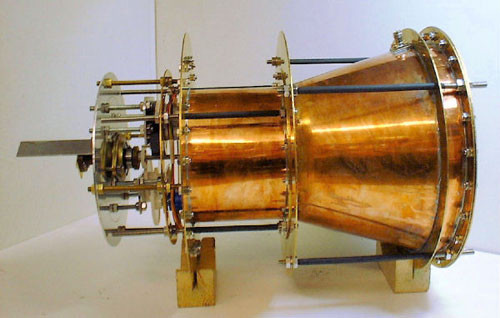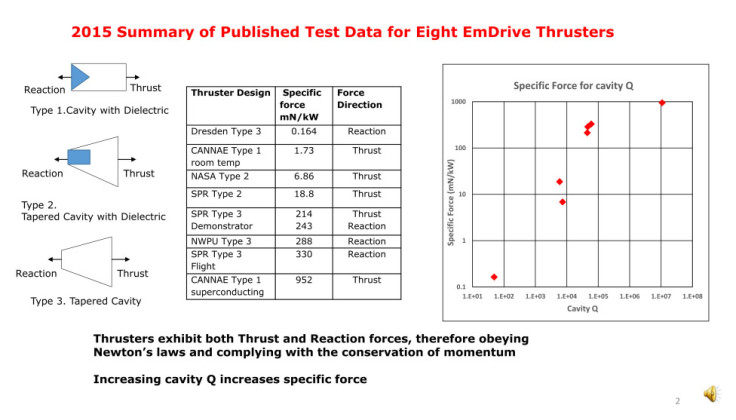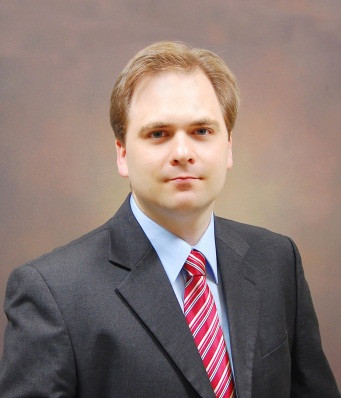EmDrive: Dr Martin Tajmar generates thrust in test of controversial space propulsion technology

German professor Dr Martin Tajmar has presented results on experiments conducted with the controversial electromagnetic space propulsion technology EmDrive that he claims shows the theoretical technology generated thrust.
The key figure in the discussion of this theoretical technology is British scientist Roger Shawyer, who devised the EmDrive concept and first presented it in 1999, but spent years having his technology ridiculed by the international space science research community.
According to Shawyer, if the technology is ever commercially realised, EmDrive could transform the aerospace industry and potentially solve the energy crisis, climate change, and speed up space travel by making it much cheaper to launch satellites and spacecraft into orbit.
Tajmar, Professor and Chair for Space Systems at the Dresden University of Technology's Institute of Aerospace Engineering, presented a paper entitled "Direct Thrust Measurements of an EmDrive and Evaluation of Possible Side-Effects" at an American Institute of Aeronautics and Astronautics conference in Orlando, Florida, on 27 July.
Tajmar claims that his team were able to connect the EmDrive to a commercial 700W microwave magnetron, which produced thrusts of +/-20µN (micronewton) that were measured in high vacuum (range between one millionth and one thousand millionth of nominal atmospheric pressure) at a low Q factor of <50.

"Our test campaign cannot confirm or refute the claims of the EmDrive but intends to independently assess possible side-effects in the measurements methods used so far. Nevertheless, we do observe thrusts close to the actual predictions after eliminating many possible error sources that should warrant further investigation into the phenomena," the researchers wrote in their paper.
"The nature of the thrusts observed is still unclear. Additional tests need to be carried out to study the magnetic interaction of the power feeding lines used for the liquid metal contacts.
"Next steps include better magnetic shielding, further vacuum tests and improved EmDrive models with higher Q factors and electronics that allow tuning for optimal operation. As a worst case we may find how to effectively shield thrust balances from magnetic fields."
Tajmar told IBTimes UK that he feels his EmDrive experiments are just a "work in progress" at the moment. "I believe there is no real news here yet. I specifically wrote in the abstract and conclusion of the paper that our measurements can not confirm or refute anything here regarding the EmDrive."
"After building our own setup we did indeed measure effects similar to what you would expect from an EmDrive - but also in directions where you would expect zero thrust. Our setup therefore produced a null effect within our measurement resolution which is on the order of the claimed thrust – we did identify magnetic forces from the power cables that may still lead to a significant influence which must be assessed in future work."
Tajmar has experience in researching and debunking space propulsion systems through experiments, so his results should carry some weight. Of course, as he points out himself, they are unable to explain how EmDrive produces thrust, or if indeed there are other factors obscuring their results. This echoes the findings of Nasa's Eagleworks researchers in April.
Tajmar's results in line with existing EmDrive research

How does EmDrive work?
As described by Roger Shawyer, EmDrive harvests the force of electromagnetic waves within a cone-shaped system, because the force exerted is greater at the larger end of the cone, therefore producing thrust momentum in that direction.
Shawyer further states that this apparent closed-system is based on the theory of special relativity "in which separate frames of reference have to be applied at velocities approaching the speed of light" and therefore should be regarded as an open system.
Shawyer's critics say that according to the law of conservation of momentum, his hypothesis cannot work as momentum generated in one direction requires an expulsion of propellant energy in the opposite direction, and the EmDrive is a closed system.
Shawyer consulted with Tajmar for his study, and he has included Tajmar's research in a new paper entitled "Second generation EmDrive propulsion applied to SSTO launcher and interstellar probe" that has been peer reviewed by the International Astronautical Congress (IAC) and published in the journal Acta Astronautica.
"In a five-minute-long video presentation that goes with my paper, there is a graph where I've plotted all the data that's been published, from our own work, to the work of the Chinese scientists, to the American work, and now the German work," Shawyer told IBTimes UK.
The graph is a linear set of characteristics that map out the research from eight different thrusters made by five different research groups in four countries.
"I've taken Tajmar's data and added a point to a graph, and it shows exactly as predicted that the force is dependent on the Q, and it proves that the specific thrust (force per unit power) increases as the Q increases," Shawyer explained.
"If you plot force per unit power against Q, you should get more or less a straight line. What Tajmar's work has done is produce the bottom point of that set of characteristics."
Critics say Tajmar's EmDrive still violates momentum conservation
The scientific community has been arguing against Shawyer's proposal on the grounds of the law of conservation of momentum since Shawyer introduced the concept in 1999. This has not abated despite his explanations to the contrary.
"The results are actually down to the theory of special relativity – basically fundamental physics – which has been well understood for the last 100 years," Shawyer told IBTimes UK in April regarding the Nasa experiments.
Eric W. Davis, a Senior Research Physicist at the Institute for Advanced Studies at Austin, Texas, told io9 that Tajmar's thruster violates momentum conservation, and he also says that the thrust signals Tajmar reported are actually "false positives".
"I noted in [the study's] conclusion paragraphs that [Tajmar's] apparatus was producing hundreds of micro-Newtons of thrust when it got very hot and that his measuring instrumentation is not very accurate when the apparatus becomes hot," said Davis.
"He also stated that he was still recording thrust signals even after the electrical power was turned off which is a huge key clue that his thrust measurements are all systematic artifact false positive thrust signals.
"The experiment is quite detailed but no theoretical account for momentum violation is given by him, which will cause peer reviews and technical journal editors to reject his paper should it be submitted to any of the peer-review physics and aerospace journals."

Go do the maths yourself, says Shawyer
Shawyer is sceptical of Davis' comments and feels that there are far too many "armchair scientists" getting in the way of real innovation.
Many critics have accused Shawyer of fraud, but his work, which was first presented at the IAC 2014 conference in Toronto in October 2014 has now published by a peer reviewed journal, and he sees no reason why Tajmar's work won't be too.
"This is real life – there are bound to be experimental effects that need to be explained. Trying to explain it without knowing the details of the experimental equipment, is not good," said Shawyer.
"It's really no wonder people don't like presenting data when they're subject to this sort of nonsense. Proper professional criticism is fine but it should be written down and aired in a forum. This shouting and throwing mud at people in the media is unprofessional."
Shawyer says Tajmar's results are "exactly in line with the EmDrive theory" and that people who want to criticise need to "do the maths" first.
"If you don't understand something and it's a difficult something, then what you should do is go away and listen, and read, and then you should go away, and if you're capable of it, you should do the maths. That's the key to it," he said.
"Once you've done that, and you're really serious, then you go and do your experiments, and then think about it for one to two years. Because that is what real scientists do, and they're seeing that EmDrive does work."
© Copyright IBTimes 2025. All rights reserved.





















